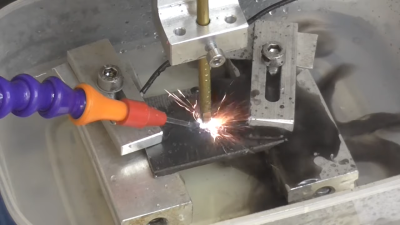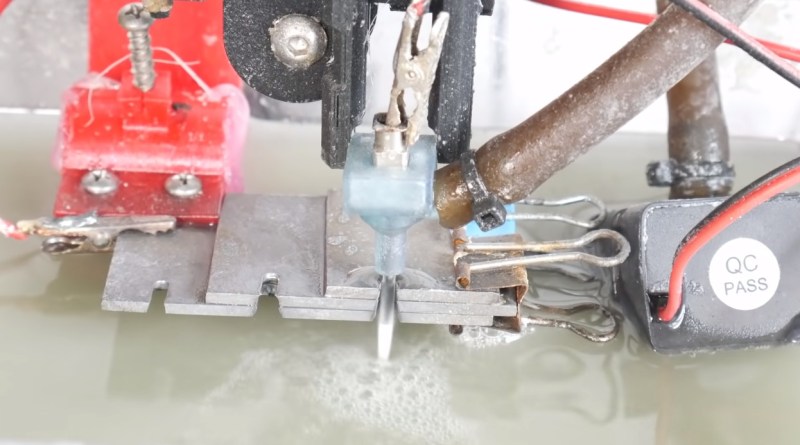As a Hackaday reader, it’s safe to assume you’ve got a better than average understanding of electricity. There’s also an excellent chance you’re familiar with machining, and may even have a lathe or old mill in the workshop. But combining the two, and actually machining a piece of metal with electricity, isn’t something that many home gamers can boast first-hand experience with.

Of course, that doesn’t mean there isn’t an interest. To help answer the burning (or at least, sparking) questions from the community, CEO and founder of Voxel Innovations Daniel Herrington stopped by this week’s Hack Chat to talk about the cutting edge of both electric discharge machining (EDM) and the closely related field of electrochemical machining (ECM). While his company uses the technology to produce components at incredible scales, Daniel got his start tinkering in the garage like so many of us, enabling him to provide both a professional and hobbyist prospective on the technologies.
Naturally, the first big question to be addressed was the difference between EDM and ECM. Put simply, electric discharge machining uses high-voltage to literally blast away material from the workpiece. The resulting finish is generally rough, and progress through the material tends to be slow, but it’s relatively simple to implement.
In contrast electrochemical machining could be thought of as a sort of reverse electroplating process, as the material being removed from the workpiece is dissolved and transferred to the cathode — though in practice the flow of pressurized electrolyte keeps it from actually plating the negatively charged tool. ECM is a faster process than EDM and allows for an exceptionally smooth surface finish, but is considerably more challenging from a technical perspective.

So why use electricity to machine metal instead of traditional tools? Both ECM and EDM have a unique advantage: the tool never actually touches the piece being worked on. This obviously places less stress on the material than cutting, but also means the machine itself doesn’t need to be as mechanically rigid, the motors don’t need to be as strong, etc. The non-contact nature of ECM/EDM is especially compelling for hobbyists, as it means a cheap 3D printer can be repurposed to move the tool over the workpiece.
Unfortunately, hacking a 3D printer to move the tool around is perhaps the only aspect of ECM or EDM that could really be called “easy” from a hobbyist perspective. As Daniel explains, one of the biggest issues is that of tooling. If you’re doing EDM your electrode will be made of something like graphite or brass, which on the plus side isn’t terribly expensive and is fairly easy to work with. Unfortunately, the electrode is consumed during the process, so you’ll need to make a lot of them. As for ECM, the good news is that the cathode doesn’t get worn down while machining like in EDM. On the other hand, it needs to be made of something like stainless steel to survive the chemical processes at play. Producing tools for complex shapes can therefore become very expensive, and only makes sense in commercial applications if you can amortize the cost over many parts.
Of course, if we’re talking about a personal project, maybe you aren’t concerned about the time and effort involved in creating the ECM tooling. In that case, you’re biggest problem is going to be the electrolyte. There’s various specific mixtures used, but generally speaking you’re going to be running your tool through salt water. In fact, Daniel says Voxel usually uses sodium nitrate, which is commonly used for preserving food. There’s nothing inherently dangerous about that, but in practice, the corrosive liquid splashes all over the place as the tool moves around. If that wasn’t bad enough, electrolysis breaks down the salt water into hydrogen and oxygen — a potentially explosive combination. As an added bonus, if you try and do it with standard table salt, you’ll produce poisonous chlorine gas as well.

Several attendees in the Chat chimed in with their own stories about trying to wrangle ECM on the desktop, and it doesn’t sound pretty. No matter how you try and seal up the work area, the salt water gets into everything, rusting linear rails and shorting out electronics. All the while, you’ve got to make sure all of the gasses being generated are properly vented. But if you’re willing to put in the effort, the results can be extremely impressive.
The short version of all this is that pulling off EDM or ECM in the home shop is difficult, maybe even a bit dangerous, but certainly not impossible. Whether or not it makes sense to spend time chasing the ability to machine metal with electricity rather than just picking up an old Bridgeport from Craigslist is of course another story. Even in the commercial world, Daniel says the technology really only makes sense when you’re looking to produce thousands or even millions of parts. Of course, turn back the clock 20 years or so, and who could have imagined that hackers and makers would have personal 3D printers and laser cutters? Perhaps in the coming decades, EDM/ECM rigs will be a common a sight at the hackerspace as an Ender 3 is today.
Special thanks to Daniel Herrington for sharing his knowledge about this fascinating technology with the Hackaday community. We were also glad to see others chime in with their own success stories and projects — while there may only be one official host, that doesn’t mean others can’t share their relevant experience with the group. It was a great way to kick off a new year of Hack Chats, and we’re excited to talk with a whole new slate of hosts in 2023. If you’d like to host a Chat of your own, simply fill out the application form and let us know what you’d like to talk about.
The Hack Chat is a weekly online chat session hosted by leading experts from all corners of the hardware hacking universe. It’s a great way for hackers connect in a fun and informal way, but if you can’t make it live, these overview posts as well as the transcripts posted to Hackaday.io make sure you don’t miss out.
















Sodium nitrite, not nitrate is whats typically used as curing salt for meats. The nitrates potassium, sodium, and ammonium are oxidizers and used in blackpowder formulations, fertilizers, and explosives.
I’m amazed how versed people have become dabbling in machining, learning g-code, programming microcontrollers and yet are totally clueless to the basic concepts of chemistry.
A while back I remember thinking maybe I should add a bit of chemistry to my mental tool set.
And then there was a component decapping article here on HaD along with a discussion of the acid used and how you don’t even feel it as it eats down into your bones releasing calcium into your bloodstream causing a fatal heart attack.
Nevermind.. I’ll stick with the less reactive tools and methods.
Sounds like hydrofluoric acid. But is that really any different from the people playing around with x-ray tubes or high voltage? You take precautions to avoid accidents. Besides, you dont have to deal with hydrofluoric acid to learn basic stuff about chemistry. A little bit like saying you’ll stay away from all electronics because some circuits can kill you.
Simply said nitrite for wet cures, nitrate for dry cures.
Both nitrite and nitrate are used in food preservation.
I wasn’t allowed to take chemistry in high school because I was on the naughty list. Then I dropped out. lmao
Less Unabombers with a electricity background.
Who needs an electricity background if there is YouTube? Or any background at all?
It was a pleasure to learn from Daniel’s expertise on ECM! I’ve been keeping an eye on his company for a while now. I’m confident that desktop EDM will be available much sooner than a decade. In fact, I’m already working on it! Make sure to keep up with the latest updates by signing up for the mailing list at rackrobo.io.
I recently read about a kilometer long nested annulus, or sequential laser pulse arrangement, where the first laser pulse, or maybe annulus, ionized atmospheric air, and motionized it so it got out of the way, leaving a vacuum channel, then a second laser, or laser pulse with lots more energy traveled through the vacuum channel to beam a whole bunch of energy to one location. It might be possible to do something similar with lasers, electricity, electricity traversing near vacuum plasma, or even electron beams to do electromachining very affordably.
Wonder why they’re not trying washing soda (sodium carbonate) since it’s regularly used in electrolytic rust removal.
Put simply, electric discharge machining uses high-voltage to literally blast away material from the workpiece. The resulting finish is generally rough,
Not so, The Agie wire eroder I worked on could achieve an excellent finish with extreme accuracy.
It might have been smooth compared to other machines, but the pitted surface finish is a known downsides of EDM. You’re blowing the material away with sparks, there’s no way to make it perfectly smooth.
With EDC, you can get an actual mirror finish on a piece.
If you can use an electrochemical process to machine like that, can you reverse it and use it for deposition 3d printing?
It’s been done:
https://sciencetrends.com/electrochemical-additive-manufacturing-low-cost-desktop-3d-printer/
I recently read about a kilometer long nested annulus, or sequential laser pulse arrangement, where the first laser pulse, or maybe annulus, ionized atmospheric air, and motionized it so it got out of the way, leaving a vacuum channel, then a second laser, or laser pulse with lots more energy traveled through the vacuum channel to beam a whole bunch of energy to one location. It might be possible to do something similar with lasers, electricity, electricity traversing near vacuum plasma, or even electron beams to do electromachining very affordably.